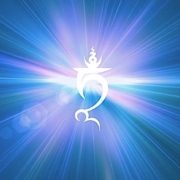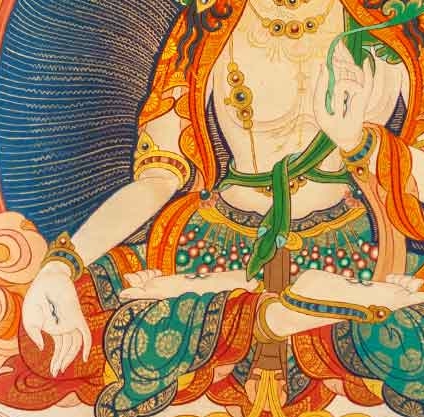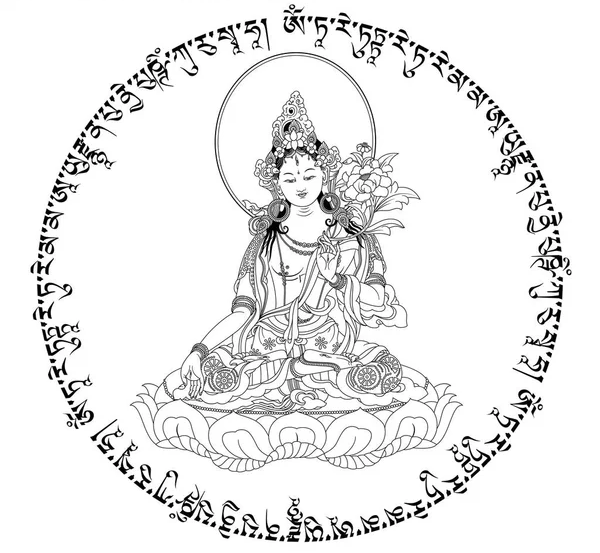White Tara
The Embodiment of Motherly Compassion.
Meditate and connect with the vast unified field of ALOHA.
Recite the Proclamation of ALOHA:
May ALOHA’s presence dawn
May the confidence of ALOHA be eternal
May ALOHA be all victorious
May ALOHA bring profound, brilliant, glory
Repeat 3 times:
To the Buddha, the Dharma, and Spiritual Community, I go for refuge until I’m enlightened.
Repeat 3 times:
By practicing generosity, discipline, patience, exertion, meditation, and prajña, may I become a Buddha in order to benefit all sentient beings.
Visualization
Above the crown of your head, the transcendental wisdom of all the Buddhas manifests as White Tara. Her body is in the nature of radiant white light. She has one face and two arms. Her right hand is on her right knee in the gesture of granting supreme realizations, and her left hand at her heart holds the stem of an utpala flower. Youthful and beautiful, she is seated in the vajra posture. She has all the signs and marks of a Buddha and has seven eyes (face, palms, soles, third eye). She looks at you and all sentient beings with complete acceptance and compassion.
 At Tara’s heart is a horizontal white moon disk. At its center is the white syllable TAM, the essence of her enlightened realizations. Light rays shine forth from the TAM and hook back all the life force that has been scattered or lost. This dissolves into the TAM in the form of light. Again light rays radiate from the TAM and hook back the power and inspiration of all the Buddhas, bodhisattvas and those who have attained the realization of long life. This dissolves into the TAM. Also, the essence of the four elements of earth, water, fire and air, as well as the space element, absorb into the TAM in the form of five-colored nectar-light (white, yellow, red, green, blue).
At Tara’s heart is a horizontal white moon disk. At its center is the white syllable TAM, the essence of her enlightened realizations. Light rays shine forth from the TAM and hook back all the life force that has been scattered or lost. This dissolves into the TAM in the form of light. Again light rays radiate from the TAM and hook back the power and inspiration of all the Buddhas, bodhisattvas and those who have attained the realization of long life. This dissolves into the TAM. Also, the essence of the four elements of earth, water, fire and air, as well as the space element, absorb into the TAM in the form of five-colored nectar-light (white, yellow, red, green, blue).
From the TAM at her heart, light and nectar now flow into your body. They fill your entire body, dispelling all negative karma, disturbing attitudes, negative emotions, disease, interferences, and dangers of untimely death. All these leave your body in the form of dirty liquid, and your body becomes pure and clear. Your mind too becomes clear and blissful.
Mantra
Repeat this long version while striking the mudra of White Tara (see below) 21 times while holding the visualization above.
OM TĀRE TUTTĀRE TURE MAMA AYUH PUNYA JÑANA PUSHTIM KURU SVAHA
Then repeat this short version while striking the mudra of White Tara (see below) for the rest of the Mala (87 more times) while continuing to hold the visualization above.
OM TĀRE TUTTĀRE TURE SVAHA
While repeating the mantra, think and feel, “I am liberated from all negative karma, disturbing attitudes, negative emotions, disease, interferences and dangers of untimely death. I will use my life in a meaningful way to transform my mind; develop love, compassion, and the six far-reaching attitudes; and act in ways that benefit others, myself, and our environment.”
Dedication
By this merit and virtue, may I liberate all sentient beings from the dark age and establish them in the completely enlightened palace of wisdom.
Aspiration
May anyone who merely sees me, hears me, remembers me, touches me, or talks to me be freed in that very instant from all sufferings and abide in happiness forever.
May the glorious spiritual masters live long, and may all beings throughout limitless space be happy. By purifying our defilements and accumulating positive potential, may I and all others be inspired to attain Buddhahood quickly.
Dedication of Merit
In anjali:
By this merit may all obtain omniscience. May it defeat the enemy: wrong-doing. From the stormy waves of birth, old-age, sickness and death, From the ocean of samsara may I free all beings.
In warrior posture:
By the confidence of the Golden Sun of the Great East, May the lotus garden of the Rigden’s wisdom bloom. May the dark ignorance of sentient beings be dispelled. May all beings enjoy profound brilliant glory.
Commentary
Tara is closely related to Chenrezig (Avalokitesvara), the Bodhisattva of Compassion. One story of her origin says that she was born from Chenrezig’s compassionate tears. People also think of her as the female manifestation of Chenrezig, or his consort.
Though all the manifestations of Tara share the characteristic of compassion through this connection to Chenrezig, it is White Tara who is most closely linked to his essential compassionate nature.
Her pure compassion for our suffering, which is thought to be greater even than a mother’s love for her child, is symbolized in images of White Tara by her white color. Her whiteness also indicates the “undifferentiated truth of the Dharma.”
In comparison to Green Tara, who is shown seated with one leg on the ground, ready to come to our defense, White Tara is seated in the more meditative diamond lotus position, with both legs folded under her, and her feet facing skyward.
White Tara has 7 eyes — with an eye in her forehead, and one on each hand and foot — symbolizing her compassionate vigilance to see all the suffering of the world.
Her left hand is in the protective mudra and her right in the wish-granting mudra. In her left hand she usually holds a stem of the Utpala lotus flower with three blossoms. One blossom is represented as a seed, a second as ready to bloom, and the third in full bloom. These represent the Buddhas of the past, future and present.
The Mantra
OM TĀRE TUTTĀRE TURE MAMA AYUH PUNYA JÑANA PUSHTIM KURU SVAHA
Om – is considered to be the ”primordial sound.”
Tare – this syllable shows that Mother Tara liberates sentient beings from samsara.
Tuttare – liberates you from the eight fears, attachment, ignorance, anger, pride, miserliness, jealousy, doubt, and wrong views.
Ture – this syllable liberates you from the disease.
Mama – translates as ”mine,” and represents ”that I would like to possess the following traits.”
Ayuh – translates as ”long life.”
Punya – represents the merit that comes from living life ethically.
Jñana – translates as ”wisdom.”
Pushtim – translates as ”abundance” or ”an increase in wealth.”
Kuru – translates as ”do so! do it now.”
Svaha – translates as ”may blessings be upon” and is a common ending to Buddhist mantras.
The Mudra of White Tara
Hold your right hand in the gesture of giving (flat hand, palm facing forward, fingers pointing down) while you hold the left hand in the gesture of The Three Jewels (hand facing out while touching thumb and ring finger). As illustrated below:


